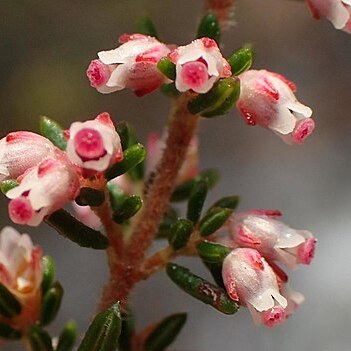Erect shrub, 0.6-1.2 m high. Leaves 3-nate, erect, 2-3 mm long, linear-trigonous, imbricate, sulcate, glabrous. Flowers 3-nate in many clusters at ends of branchlets, sub-calycine; bracts variable in number and degree of fusion with sepals. Calyx sepals as long as corolla tube, ovate-lanceolate to ovate or suborbicular, acute, obtuse or apiculate, concave, transparent, pallid, ciliate or naked. Corolla 2 mm long, broadly cyathiform, dry, glabrous, rosy; lobes erect, obtuse, slightly shorter than tube, pink. Filaments filiform; anthers manifest or half-exserted, 1 mm long, lateral, oblong to subovate, subacute, scabrid, brown to dull red, muticous; pore 2/3 length of theca. Ovary small, ovoid, minutely pubescent; style exserted, red; stigma cyathiform, large, with 4 intramarginal short points, bright crimson to red, ± 1 mm in diam. Flowering time Sept.-Apr.
Erect shrub to 1.2 m. Flowers small, subcalycine, cup-shaped, pink.

